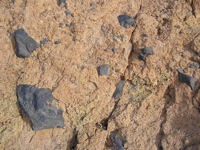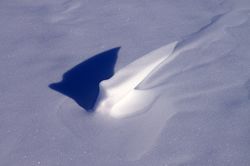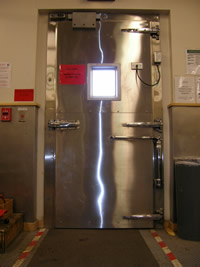Saturday evening, in the laboratory, before a pc. At about 8 p.m. I try to remember the last time I turned it off, but I don’t manage. Bad sign. After a while, Julian, my New Zealand teachmate, comes in with an uncoded, catatonic look. We look at each other, we laugh and (maybe) we do not even say. Silently we go out of the laboratory and we know: tomorrow we are going to Castle Rock.
The environs of Mc Murdo offer good chances to have some brief healthy trips. There is only one problem: here we are in Antarctica. It counts little if you live in the most equipped and comfortable base of the continent; as soon as you go out, it is the master. And, we have understood, it does not joke. During recreational activities, accidents, due to different causes, are not unusual. Some of them, unfortunately, did not have a happy end. In order to solve the problem, rigid rules were established.
One: whoever goes in for outdoor activitites has to follow a specific course (just 3 hours).
Two: before the departure, you have to state the exact data (way, start, arrival, participants etc.) in a dedicated area of intranet, the informative net of the base.
Three: right before leaving the base, you have to go the firemen’s barracks for the final permission, given according to the weather forecast, and for the emergency radio.
At about 11 o’clock, we succeed in finishing the scheduled liturgy and, dressed like divers, we walk towards Castle Rock: a rocky formation emerging in the middle of Ross Isle, at 5 km from the base. It is the longest route and during the return we reach Scott base: 16 km, 6 forecast hours. After half an hour walk and a brief stop in an emergency refuge (called “the apple”, for its shape and colour), we reach Castle Rock. We feel well and we decide to go along the road towards the top.
 And we do well. The top is flat and without snow, the rock is brick red, porous and friable, with big fragments of black rock, many of which vacuolar. I pronounce the name Franco told me: ‘ialoclatsiti’. Probably, the fruit of a remote lave flow in the ice. We look around and we find nothing like what we have seen before.
And we do well. The top is flat and without snow, the rock is brick red, porous and friable, with big fragments of black rock, many of which vacuolar. I pronounce the name Franco told me: ‘ialoclatsiti’. Probably, the fruit of a remote lave flow in the ice. We look around and we find nothing like what we have seen before.
Heavy and low clouds quickly follow the profile of the volcano Erebus, parts of others, taller and more laminar, draw shadows moving over the ice towards a horizon that joins white and azure in every possible way, according to the direction you look at: white/azure, white/sky-blue; white/white… We sit down. We stay and watch silently for half an hour, just like we did a few hours before in the laboratory. Then, lazyly, we take our cameras and take some shots. In the meanwhile, the wind is blowing, rather convincing in inviting us to descend and we do not take much persuading.
 “In Antarctica that does not happen..” you think, “..in Antarctica children are always happy; they watch so much snow falling down!” But it is not so.
“In Antarctica that does not happen..” you think, “..in Antarctica children are always happy; they watch so much snow falling down!” But it is not so. Yesterday it was -29°, without considering the wind. I look for a sign letting you know, the clearest way, what means lesstwentyninedegrees and I find it at once: the doors! I think you recognize something familiar in the photo. Have you ever entered the kitchen of a restaurant or the backs of some butchers’ shops? No? Well, try; you will find cold stores. Places for the preservation of food at several degrees. About twenty years ago in every house there were freezers with a hook. They are still trendy and you can find them in some glamour houses on retrò freezers. Here in Antarctica the doors are like those ones. And I assure you they are not there for show.
Yesterday it was -29°, without considering the wind. I look for a sign letting you know, the clearest way, what means lesstwentyninedegrees and I find it at once: the doors! I think you recognize something familiar in the photo. Have you ever entered the kitchen of a restaurant or the backs of some butchers’ shops? No? Well, try; you will find cold stores. Places for the preservation of food at several degrees. About twenty years ago in every house there were freezers with a hook. They are still trendy and you can find them in some glamour houses on retrò freezers. Here in Antarctica the doors are like those ones. And I assure you they are not there for show.